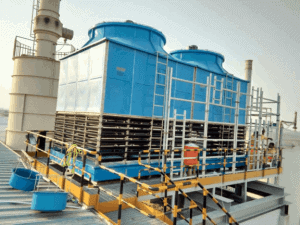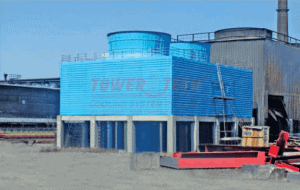The operational efficiency, operating and equipment costs, and reliability of a cooling system are influenced by the cooling tower water treatment and quality. Let us take a look at the 4 primary cooling tower maintenance problems and their specific solutions.
Regardless of the brand and quality, equipment and machinery should be handled with much care in order for them to last longer and to function well the way they should be. The same goes for cooling towers.
A good cooling system is essential for a good business. That is why you need to ensure that inspections, repairs, and maintenance are done regularly and continually. Not only will these ensure equipment longevity, they likewise help avoid unnecessary extra operating costs and prevent serious cooling tower problems which may call for more expensive major repairs.

What are the most common cooling tower issues?
The operational efficiency, operating and equipment costs, and reliability of a cooling system are influenced by the cooling tower water treatment and quality. Below are the 4 primary cooling tower maintenance problems.
Cooling Tower Corrosion
Corrosion is one of the major cooling tower issues that need to be properly addressed. Unfortunately, this issue is often overlooked and ignored, thinking that it is just normal especially for those decades-old cooling towers. Corrosion is the result of the reaction of the metal surface with elements around the environment inside the cooling tower like aerated cooling water, microbiological growths, surface films, and scale deposits.
If left unaddressed, corrosion can fester and worsen. When this happens, repairs may not be enough. You may be required to replace parts or perhaps the entire cooling tower itself. Replacing the entire cooling tower or even damaged parts is not only extremely costly, but it can also potentially harm other areas within the cooling system and affect your operation, leading to additional losses.
Corrosion Solution
The good thing is that cooling tower corrosion can be prevented. Through regular inspections, you can be able to identify small issues that can trigger corrosion. Very minor issues like scale build-up and small water leakage from a closed-loop system should not be taken for granted as they can trigger corrosion and further damages.
Preventive measures include
- Investing in high-quality polymeric coating solutions
- Regular maintenance
- Immediate response to minor issues
- Periodic inspection especially in highly corrosive areas like joints, seams, diffuser trays, holding pans, and framework.
Scaling
Compounds that are soluble in water with a low temperature usually become insoluble in water with high temperature. When high temperature minimizes the solubility of certain compounds present in the water like magnesium silicate, calcium phosphate, silica, and calcium carbonate, hard deposits can be formed within the cooling system’s heat exchange surfaces. This phenomenon is known as scale.
Scaling can plug up over time and damage the internal surfaces, pipes, and even the cooling system itself. Moreover, scaling can reduce cooling tower efficiency, and decrease heat dispersal while increasing energy consumption.
Apart from temperature, the amount of scale-causing contaminants in the water and the pH level or alkalinity of the water can likewise cause scaling and can help determine the amount of scale that can be accumulated in your cooling tower. Certain compounds tend to get less soluble as the water alkalinity increases. Moreover, when the water is heated, their precipitation rates also gets higher.
Regardless of the pH level and temperature of the water, there are still possibilities that your tower can accumulate scale if the scale-causing contaminants in the water are greater in volume than their natural saturation point.
Scaling Solution
The most effective solution for cooling system scaling is:
- Concentration cycles and blowdown monitoring
- Circulation side-stream filtration
- Feedwater treatment
- Chemical scale inhibitors
- pH control
Cooling tower systems have different individual features and characteristics. If you are not sure what type of water treatment to use, you may ask for advice from your cooling tower exporter or supplier, or perhaps seek help from a water treatment specialist.

Fouling
Fouling is generally defined as the build-up of unwanted materials or deposits on a solid surface. In cooling towers, fouling causes are not only limited to dirt, dust, and debris. It can likewise be caused by other materials (both living organisms and non-living substance) like silt, colloidal and suspended solids, microbiological growth, biological contaminants, migratory corrosion products, and sand. Though fouling is similar to scaling, its deposits are less hard than that of the latter.
Fouling should be dealt with as soon as identified to avoid deposition from getting severe enough to cause a variety of issues including dramatically reduced cooling tower efficiency, and plugged pipes and heat exchangers. It can also cause operational and energy costs to skyrocket and it interferes with system function.
Fouling Solution
There are different available solutions to fix fouling problems. However, identification of the solution to be used should depend on the type of contaminant or material that caused fouling as well as the area at the cooling tower process where the issue occurred. Among the most effective water treatment options and solutions for fouling are:
- Regular and close monitoring
- Chemical dispersants
- Periodic blowdown
- Side-stream filtration
Microbiological Contamination
Microbiological contamination or biological contamination is the accidental or unintentional introduction of microbes like fungi, algae, bacteria, protozoa by-products and toxins, mold, and yeast within the cooling system. Microorganisms can enter the cooling systems in two ways. It can either be by means of the air that passes through the tower or via the inflow of water.
Water evaporation, water use, and process leaks can all increase nutrient content in water used on an evaporative cooling tower. With an abundant supply of nutrients and warm water, the cooling system becomes an ideal environment for pathogenic microorganisms to grow and thrive.
As the bacteria continue to grow and multiply, they form a biofilm or biological film which is not only infectious in nature but is also harmful to the cooling system operation. Biofilm formation is known for its strong insulating property, (in fact, it is 4-5 x stronger than the calcium carbonate scale’s insulating property). The biological film does not only promote cooling system corrosion and scaling, it can likewise increase energy consumption and cause health concerns.
Microbiological Contamination Solution
The best way to solve this issue is to control the growth of microbes in the system especially bacteria, algae, and fungi. Chemical and microbiological analysis of both the water circulating and the water inlet can help measure and control the number of pathogenic microorganisms present in the air and water within the cooling system.


